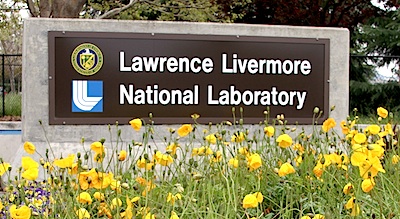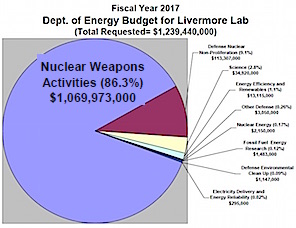
Description and Current Mission
The Lawrence Livermore National Laboratory (LLNL) is one of two laboratories that have designed every nuclear weapon in the U.S. arsenal. It was founded in 1952, at the behest of Edward Teller and Ernest O. Lawrence, to speed the development of the Hydrogen Bomb, and, more broadly, to provide competition for weapons designers at New Mexico’s Los Alamos Lab.
LLNL consists of two physical sites. The Main Site is housed on 820 acres in Livermore, California, about 40 miles east of San Francisco, and Site 300 is located on 7,000 acres between Livermore and Tracy, California, in a hilly area near Interstate 580.
Nuclear weapons activities comprised 86 percent of the DOE's Fiscal Year 2009 budget request for the Lab. The University of California managed LLNL for most of its history. Since 2007, following the first open bidding process for the Lab's management contract, it has been operated by Lawrence Livermore National Security, LLC, which is a consortium consisting of Bechtel National, University of California, Babcock and Wilcox, Washington Division of URS Corporation, and Battelle. LLNL employs about 8,000 people, of which 4,500 directly support NNSA weapons activities. Nuclear weapons development and related activities remain the principal focus at the LLNL. Nuclear weapons activities comprised 86 percent of the DOE's Fiscal Year 2009 budget request for the Lab. The Ten Year Site Plan describes LLNL's mission as national security, which it defines principally as nuclear weapons stockpile stewardship. The major goals listed are to 'extend the life of selected weapons', and 'develop replacement warheads that will enable Complex Transformation'.
The major LLNL goal in nonproliferation and homeland security is to address the 'challenge of expanding global need for civilian nuclear power and its associated infrastructure while restricting the spread of nuclear materials and weapons knowledge'.
NNSA's Complex Transformation plan elevates LLNL's role in research and development of the high explosives component of nuclear weapons, making it the 'High Explosives Research & Development Center' for the complex. In support of this expanded mission, LLNL submitted a fiscal year 2010 line-item budget request for a new 'High Explosives Application Facility (HEAF) annex'. Complex Transformation also designates LLNL as a 'Center of Excellence' for 'Nuclear Design and Engineering'. Consequently, LLNL requested fiscal year 2010 funds to begin construction of a 60,000 sq-ft 'Weapons Engineering Science and Technology' facility, to be followed in two years by an additional 60,000 sq-ft of new construction for a 'Materials Science Modernization Facility'.
The Laboratory currently:
- conducts research, design, and development of nuclear weapons;
- provides assessments and certification of stockpiled weapons;
- conducts tritium R&D;
- conducts explosive hydrodynamic tests (at the Contained Firing Facility, Site 300, 15 miles SE of the main Livermore site)
- conducts high explosives R&D;
- conducts environmental testing of nuclear weapons to determine their survivability under varied conditions;
- operates laser facilities;
- is developing capability to fabricate fusion and fission targets for the National Ignition Facility laser;
- designs and tests advanced technology concepts; and
- conducts biodefense experiments.
Lawrence Livermore FY 2017 Budget Request
For Lawrence Livermore Lab, nuclear weapons activities still dominate the budget, increasing to over 86%.
Chart by Tri-Valley CARES
Major Current and Planned Facilities
Located in the 'Superblock' at the LLNL Main Site, the Plutonium Facility was constructed in 1961 and expanded in 1977. Historical activities included fabricating bomb cores for full-scale nuclear tests and assemblies for subcritical nuclear experiments at the NTS. In its March 2005 Site Wide Environmental Impact Statement, LLNL proposed testing new plutonium bomb core casting techniques in the facility. In November 2005, the administrative limit for plutonium at LLNL was raised from 1,500 pounds to 3,080 pounds. In 2008, LLNL protective forces failed to secure the site's plutonium in a force-on-force test designed to simulate a terrorist attack. Under mounting pressure, NNSA announced it would remove all weapons usable quantities of PU and HEU by the end of 2012.
Also located in the Superblock, the Tritium Facility's historical activities included the filling of components for full-scale nuclear tests and for other, on-site experiments. In November 2005, the administrative limit for tritium at LLNL was raised from 30 to 35 grams. In 2003, LLNL began the 'Tritium Facility Modernization Project'. That project is slated to add thousands of square feet and result in the completion of an actinide capability in the tritium facility to enable production of plutonium as well as hydrogen targets for the National Ignition Facility.
Located at the LLNL Main Site, the National Ignition Facility (NIF) is a 192 beam; stadium-sized laser intended to compress deuterium-tritium targets to energies, temperatures and other conditions that exist in stars and the later stages of an exploding nuclear weapon. Funded as a weapons activity, NIF construction and related R&D have cost about $5 billion. In a November 2005 Record of Decision, NNSA added experiments with fissile and fissionable materials (e.g., plutonium, highly enriched uranium, and thorium-232) to the fusion fuel experiments already planned. Construction of a neutron spectrometer to distinguish fission from fusion-generated neutrons was undertaken. Fusion ignition experiments were scheduled to begin in 2010, but current ignition date is not known. The National Ignition Facility (NIF) has repeatedly delayed its deadline for achieving ignition, the latest being the end of FY 2012 (September 30, 2012). NIF failed, which is of growing congressional concern given $8 billion in sunk costs (its original estimate was ~$1 billion). According to congressional sources NIF will have only a few years relevancy to its funding base, the Stockpile Stewardship Program, should it not achieve ignition during that time.
The Livermore Computing and Terascale Computing Facility, at the Main Site, houses terascale computers, which support the NNSA Advanced Simulation and Computing (ASC) program, including ASC Purple and BlueGene/L.
Located at the LLNL Main Site, the High Explosives Application Facility (HEAF) supports 'all aspects' of high explosives, from research and development to material characterization to performance testing and safety experiments. HEAF supports the Energetic Materials Center, which conducts R&D of explosives, pyrotechnics, and propellants. According to the LLNL Ten Year Site Plan, a new HEAF Annex to support Complex Transformation is scheduled to be constructed at the Main Site to fabricate 'one-of-a kind explosive parts' and a 'scale-up of synthesis and formulation processes' for HEAF. This would likely require a higher explosive limit than currently allowed.
The planned Weapons Engineering Science & Technology (WEST) facility would encompass 60,000 sq-ft. Its proposed a mission is to support LLNL's role as a 'Center of Excellence for Nuclear Design and Engineering' under Complex Transformation. The anticipated start of construction is 2010 and completion is scheduled for 2016. Its total estimated cost is 'to be determined'.
A proposed Materials Science Modernization Facility is also intended to support LLNL's role as a 'Center of Excellence for Nuclear Design and Engineering'. It, too, would cover 60,000 sq-ft. The anticipated start date for construction is in 2012, with completion scheduled for 2018. According to LLNL's latest site plan, its total estimated cost is also 'to be determined'.
In 2008, an advanced bio-warfare agent research facility began operations at LLNL. The Biosafety Level-3 facility is intended to house up to 50 liters of 'select agents' historically used in bio-weapons, conduct genetic modifications, and carry out lethality experiments on small animals.
Site 300 is primarily a high explosives testing range. NNSA and its predecessors have conducted thousands of hydrodynamic detonations here since 1955, which have included wrapping high-explosives around depleted uranium (replacing plutonium in the core of the test weapon) and tritium, in addition to other materials. Still operational at Site 300 are several open-air 'firing tables' for hydrodynamic tests and the Contained Firing Facility.
The LLNL Main Site was placed on the Environmental Protection Agency's (EPA) 'Superfund' list of contaminated sites requiring priority cleanup in 1987. Site 300 earned its own place on the national 'Superfund' list in 1990.

